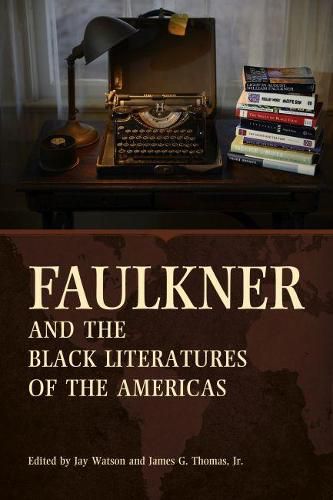Readings Newsletter
Become a Readings Member to make your shopping experience even easier.
Sign in or sign up for free!
You’re not far away from qualifying for FREE standard shipping within Australia
You’ve qualified for FREE standard shipping within Australia
The cart is loading…






This title is printed to order. This book may have been self-published. If so, we cannot guarantee the quality of the content. In the main most books will have gone through the editing process however some may not. We therefore suggest that you be aware of this before ordering this book. If in doubt check either the author or publisher’s details as we are unable to accept any returns unless they are faulty. Please contact us if you have any questions.
At the turn of the millennium, the Martinican novelist Edouard Glissant offered the bold prediction that
Faulkner’s oeuvre will be made complete when it is revisited and made vital by African Americans,
a goal that
will be achieved by a radically ‘other’ reading.
In the spirit of Glissant’s prediction, this collection places William Faulkner’s literary oeuvre in dialogue with a hemispheric canon of black writing from the United States and the Caribbean. The volume’s seventeen essays and poetry selections chart lines of engagement, dialogue, and reciprocal resonance between Faulkner and his black precursors, contemporaries, and successors in the Americas.
Contributors place Faulkner’s work in illuminating conversation with writings by Paul Laurence Dunbar, W. E. B. Du Bois, James Weldon Johnson, Jean Toomer, Nella Larsen, Claude McKay, Ralph Ellison, James Baldwin, Ernest J. Gaines, Marie Vieux-Chauvet, Toni Morrison, Edwidge Danticat, Randall Kenan, Edward P. Jones, and Natasha Trethewey, along with the musical artistry of Mississippi bluesman Charley Patton.
In addition, five contemporary African American poets offer their own creative responses to Faulkner’s writings, characters, verbal art, and historical example. In these ways, the volume develops a comparative approach to the Faulkner oeuvre that goes beyond the compelling but limiting question of influence–who read whom, whose works draw from whose–to explore the confluences between Faulkner and black writing in the hemisphere.
$9.00 standard shipping within Australia
FREE standard shipping within Australia for orders over $100.00
Express & International shipping calculated at checkout
This title is printed to order. This book may have been self-published. If so, we cannot guarantee the quality of the content. In the main most books will have gone through the editing process however some may not. We therefore suggest that you be aware of this before ordering this book. If in doubt check either the author or publisher’s details as we are unable to accept any returns unless they are faulty. Please contact us if you have any questions.
At the turn of the millennium, the Martinican novelist Edouard Glissant offered the bold prediction that
Faulkner’s oeuvre will be made complete when it is revisited and made vital by African Americans,
a goal that
will be achieved by a radically ‘other’ reading.
In the spirit of Glissant’s prediction, this collection places William Faulkner’s literary oeuvre in dialogue with a hemispheric canon of black writing from the United States and the Caribbean. The volume’s seventeen essays and poetry selections chart lines of engagement, dialogue, and reciprocal resonance between Faulkner and his black precursors, contemporaries, and successors in the Americas.
Contributors place Faulkner’s work in illuminating conversation with writings by Paul Laurence Dunbar, W. E. B. Du Bois, James Weldon Johnson, Jean Toomer, Nella Larsen, Claude McKay, Ralph Ellison, James Baldwin, Ernest J. Gaines, Marie Vieux-Chauvet, Toni Morrison, Edwidge Danticat, Randall Kenan, Edward P. Jones, and Natasha Trethewey, along with the musical artistry of Mississippi bluesman Charley Patton.
In addition, five contemporary African American poets offer their own creative responses to Faulkner’s writings, characters, verbal art, and historical example. In these ways, the volume develops a comparative approach to the Faulkner oeuvre that goes beyond the compelling but limiting question of influence–who read whom, whose works draw from whose–to explore the confluences between Faulkner and black writing in the hemisphere.